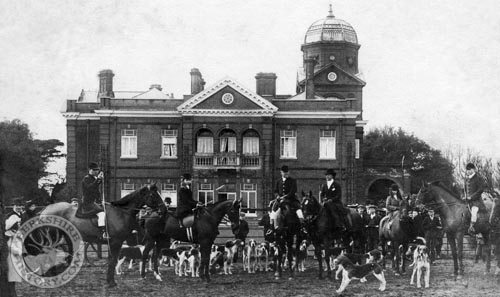 |
 |
|||
|
|
 Maiden
Erlegh House Maiden
Erlegh HouseSonning, Berkshire The park at Maiden Erlegh, on the outskirts of Reading but originally in the southern part of Sonning parish, has been the site of a minor manor house since 1362 when John d'Earley VI was allowed to split off 19 acres of his Whiteknights estate and grant it to Robert d'Earley, his brother. From the last of the d'Earleys, Richard, it passed, in 1502, to the Wiltshire family of Chaffin, who may not have been in residence. Forty years later, it was sold to the sometime Mayor of Abingdon, Oliver Hyde of Banbury Court (Abingdon). His heirs were the Hydes of Northcourt and Sutton Wick, who may possibly have used it as a residence for younger members of the family. After 1673, when the Hydes sold up, Maiden Erlegh passed through a number of hands. By the end of the 18th century, it was owned by William Matthew Birt, Governor-General of the Leeward Islands, and, in about 1781, was purchased by Edward Golding, an East India Company nabob who had amassed a huge fortune in the Sub-Continent. He eventually became Lord of the Treasury during the premiership of his neighbour, Viscount Sidmouth. The house that he erected probably survived as the core of that which survived into the late 20th century. Two generations of the Goldings lived there before Rev. Edward Golding (III) seems to have preferred his vicarage at Brimpton. In 1864, it was rented to the Master of the South Berkshire Hunt, John Hargreaves, who then bought the house and largely rebuilt it in 1878. His fireplace featuring nobly carved hunting scenes survived until the house's demolition. After Hargreaves' death, Maiden Erlegh was purchased, in 1903, by 'Solly' Joel, the lavish, yet generous, mining, brewing and railway magnet who became its most famous resident. He spent a small fortune making the house one of the most beautiful in the county, expanding it to over seventy rooms, fifty of them bedrooms, perhaps with the help of Alfred Waterhouse. Most opulent were his Italian marble winter garden and 'Pompeiianí swimming pool with colonnade surround and nude frescos. The latter was built at a cost of £12,000 (about £700,000 today) and finally sold for just £350, with the intention of shipping it to Barbados. Stories of extraordinary parties and mysterious visitors have passed into local folklore. Alas, after Solly's death in 1931, the building's life as a Boys' School and Training College were short-lived and Berkshire County Council decided against its purchase for council offices. It was demolished in 1960 and the area is now a housing estate. Maiden Erlegh House no longer stands.
|
|||
| © Nash Ford Publishing 2002. All Rights Reserved. | ||||


